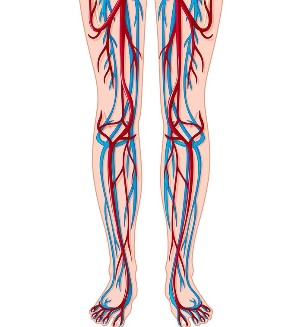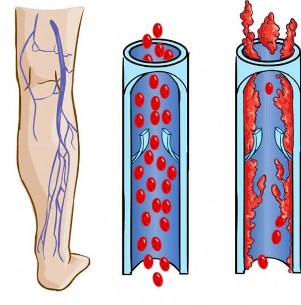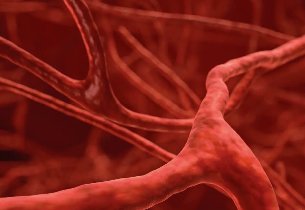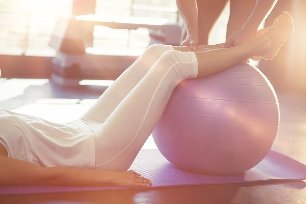Varicose veins, more commonly known as varicose veins, occur when the veins stretch and increase in size and turn blue-purple or red in color due to the accumulation of large amounts of blood. It is a common condition that most commonly affects the legs (most commonly the calf muscles) but can develop elsewhere as well.

In general, the blood supply to the cells, known from biology, takes place as follows: From the left ventricle of the heart, oxygen-enriched blood passes via the aorta into the arteries and from there into the smaller blood vessels to the capillaries, with the help of which theOrgans and tissues of the body receive oxygen and the substances they need. . . The blood is then collected from the capillaries through small blood vessels called "venules" and transported into larger veins, whose job it is to direct the blood back to the lungs and heart in order to be supplied with oxygen and to repeat its path. The mechanism for directing blood to the heart is called a venous pump.
veins are blood vessels that carry blood from the body tissue back to the heart.
Some veins have one-way valves that open to allow blood to flow to the heart and close to prevent blood flow backwards.
This is how varicose veins turn out: When the valves are damaged and don't block blood flow, it builds up in the veins, causing them to swell and stretch, leading to varicose veins. Angiosurgeons claim that varicose veins is one such pathological process in which there is a change in the vein wall with subsequent valve regurgitation.

Varicose veins generate a backflow (backflow) of blood due to valve disorders. They don't close the venous cavity, which allows blood to flow in the opposite direction. This creates increased venous blood pressure, which violates the integrity of the vein walls - they expand and protrude under the skin.
Since varicose veins are a modification of the veins, the pathology is classified not only as a vascular disease, but also as a cosmetic problem. Normal veins and varicose veins - when there is reverse blood flow and varicose veins due to a malfunction of the valve.
Why are the legs most often affected by varicose veins?
There are 3 types of veins in our legs - superficial veins that are closest to the skin; deep veins, located in the muscles and connected to the largest vein in our body - the vena cava leading to the heart; and perforating veins, connecting superficial and deep veins. The varicose veins that we see occur precisely in the superficial veins that are closest to the skin.
When we are upright, the blood in our legs should be drawn to the heart to withstand the pull. To do this, the muscles of the legs contract, pressing on the deep veins, pushing blood to the heart. When the muscles in the legs contract, the valves in the veins open, and when the muscles are relaxed, the valves close, blocking blood flow to the feet.
As you may have guessed, varicose veins in the legs are more common because the gravitational pressure, which increases while sitting and standing, has the greatest impact on venous circulation in the lower extremities.
How dangerous are varicose veins
Varicose veins are primarily an aesthetic problem for most people and are not initially a health hazard. Swollen, ugly veins can affect the appearance of certain areas of the body, but in most cases they do not affect blood flow. At the same time, it should be noted that if you do not pay due attention to the fight against varicose veins, the appearance worsens over time and complications can arise.
Causes of varicose veins
A number of factors can increase your risk of developing varicose veins:
- Factor 1 - inheritance. If someone in your family has or has varicose veins, the more likely they are inherited from you.
- Gender. Varicose veins are more common in women than men.
- Age. With age, our veins and valves become weaker.
- Disturbance of blood flow between arteries and veins.
- Hormonal changes. Hormonal changes during pregnancy, the premenstrual phase, and menopause increase the risk of varicose veins. During pregnancy, the growing fetus puts pressure on the veins in the legs. Varicose veins that appear during this time will become less noticeable after 3-12 months after the baby is born. In addition, any subsequent pregnancy increases the risk of varicose veins.
- Overweight or obese. The extra weight puts great pressure on the veins, which can lead to varicose veins.
- Sitting and standing work and a sedentary lifestyle. Standing or sitting for long periods increases your risk of varicose veins. This is because the veins have a harder time delivering blood to the heart during prolonged immobility.
Symptoms of the development of varicose veins
In addition to the appearance of protruding dark blue or purple veins, here are the main characteristics for the development of varicose veins:
- Slight swelling of the ankles and feet, especially after standing for a long time.
- Pain, burning and heavy legs.
- Leg cramps and throbbing.
- Itching in the ankles and lower legs, often incorrectly diagnosed as dry skin.
- Changes in skin color in the area of the varicose veins (bruises).
How to prevent varicose veins
According to specialists from the Department of Surgery at the University of California, the first thing a person can do to prevent varicose veins is by changing their lifestyle by adopting new habits. The same changes, although they do not help to get rid of the varicose veins that have already formed, reduce the likelihood of their appearance deteriorating, reduce pain, and save other parts of the veins from the formation of varicose veins.

What must be done to reduce the likelihood of varicose veins or to protect veins that have already been affected from deterioration:
- Do not sit or stand in one place for a long time. Try to move at least every 30 minutes.
- Do not cross your leg when sitting.
- If possible, lift your legs while sitting or lying down. Try to lift your legs so that they are above the level of your heart.
- exercise. This moves the muscles in your legs and moves blood through your veins more efficiently.
- If you are overweight, try to get it back to normal. This will help improve blood flow and reduce stress on the veins.
- Avoid tight-fitting clothing, especially around the waist, hips and legs.
- Do not wear high heels too often or for too long. Low-heeled shoes strengthen the calf muscles and facilitate blood flow through the veins.
- Exercise regularly. This will help improve blood circulation, shed extra pounds, and maintain a healthy weight.
Complications with varicose veins
According to the position of the Circulatory Foundation, this process takes a very long time, although the varicose veins worsen over time. It is also noted that in some people who have encountered varicose veins, high pressure in the veins can damage the skin in the ankle area and change its color, as well as the appearance of white scars.
If left untreated, progressive varicose veins can have more serious negative consequences:
- The appearance of ulcers
- Phlebitis
- bleeding
- Deep vein thrombosis (DVT)
If a person develops eczema (a red rash), ulcers may subsequently develop that must be surgically removed.
Phlebitis is inflammation of a vein, often accompanied by thrombosis in the affected vein that becomes hard but fragile. In most cases, this disorder does not pose a serious health risk, although it is often mistakenly confused with the more serious pathology of deep vein thrombosis (DVT).
Many people fear that an accidental blow of a varicose vein will make them bleed, but this is very rare. In this case, the blood is stopped by applying a tight gauze bandage and applying ice. The person must lie down so their legs are higher than the heart and, without taking a backseat, seek medical attention so that specialists can perform procedures that reduce the risk of rebleeding.
Some patients with varicose veins later face another pathology - deep vein thrombosis. Science is not fully known whether varicose veins directly increase the risk of DVT. The symptoms of DVT are swelling and pain, and skin that is hot to the touch. According to the US National Library of Medicine, deep vein thrombosis primarily affects the large veins in the thigh and calf muscles, and it is found that TRV almost always develops in one leg only.

Treatment of varicose veins
Compression therapy
When the first symptoms of varicose veins appear, it is recommended to wear compression clothing. Stockings, tights, or leggings apply light pressure from the bottom of the leg upwards, which reduces blood buildup and swelling. In this case, the effect will only be achieved if you wear them regularly. While wearing compression stockings will not heal existing varicose veins, it will help prevent or reduce varicose veins and other complications.
In addition, the Society for Vascular Surgery (SVS) states in its clinical guidelines for the treatment of patients with varicose veins of the lower extremities and pelvis: "The wearing of stockings is the first therapeutic procedure for patients in whom during the progression of theVaricose ulcers were removed. "
Endovenous ablation (high frequency or laser)
With endovenous ablation, the varicose vein is closed or removed with the help of laser or radio frequency therapy. The doctor makes a tiny incision in the skin near the vein and inserts a catheter. After that, a special device is connected to the tip of the catheter, with the help of which the catheter heats up and the varicose vein closes or removes (depending on the chosen ablation method). The procedure is performed under local anesthesia and the patient usually returns home the same day.
Endovenous ablation is one of the most effective and safest treatments for varicose veins. The Society for Vascular Surgery (SVS) recommends that this procedure be preferred to the surgical method for treating superficial varicose veins.
Sclerotherapy
This is another gentle method of treating varicose veins. During the procedure, a special substance is injected into the vein affected by varicose veins, which breaks the inner lining of the vein and causes the blood to clot in the vein. Over time, the vein collapses and disappears.
Surgical method
In advanced cases of varicose veins, gentler treatments will not help correct the situation. In this case, the person will be referred for an operation that will surgically remove the superficial vein. The indications for an operation are:
- ulcers or the risk of their occurrence,
- bleeding,
- Phlebitis.
The procedure is performed under general anesthesia and the patient is usually allowed to go home the same day. For 2 weeks after the surgery, a person may experience pain and discomfort.
The Blood Circulation Fund notes that deep vein thrombosis can sometimes develop after surgery. However, the risk of this pathology can be reduced by wearing compression stockings and maintaining high levels of physical activity.
Varicose veins and training
Lots of exercise and moderate exercise are the most important helpers in the fight against varicose veins.

While some training methods are helpful and recommended for preventing varicose veins, others can be harmful.
Moderate, rhythmic physical activity (such as walking) is beneficial in preventing varicose veins and helping to minimize the likelihood of complications, as dynamic muscle movements help direct blood from the periphery to the heart.
Go
Walking is one of the best movements for preventing varicose veins and promoting healthy blood flow by stretching and contracting the venous pump in the calf muscles. Walk for at least 30 minutes at least 5 times a week.
Running with low intensity
Running at a slow pace works well for the calf muscles, but it has one disadvantage: running stresses our joints. If you're not ready to replace running with another activity, run on grass or rubberized paths, not hard asphalt.
Elliptical & exercise bike
Elliptical trainers and stationary bicycle training actively activate the calf muscles and promote healthy blood circulation. In addition, the joints are less stressed than when running.
Strength training
People with varicose veins should avoid excessive strength training. With prolonged irregular muscle tension, the muscles of the legs and ventilation pumps do not contribute to the return of blood via the veins to the heart. Because of this, blood accumulates in the leg veins during exercise, which can only contribute to the further development of varicose veins. In addition, the increase in intra-abdominal pressure during exercise also hinders blood flow.
Squats, lunges and crunches are particularly important when doing exercises that negatively affect the venous circulation.
People with varicose veins need to train lightly and do relatively high repetitions in sets without fail. In addition, it is recommended that you pedal on a stationary bike or exercise on an elliptical trainer to restore normal blood flow after strength training. It is also recommended to wear compression stockings during and after strength training.
Why do the veins bulge more strongly in summer

As from experts of the V. I. St. John and the hospital. Saint Joseph Wayne, in summer the veins bulge more because, under the influence of heat, they expand and fill with more blood, increasing in size.
Follow these simple guidelines to reduce vein swelling in summer:
- Lubricate the skin with a thick layer of moisturizing SPF cream.
- If you are outdoors for long periods of time, try to hide in the shade.
- Don't sunbathe too long.
- Swim regularly. By doing this, you are doing cooling on your body and preventing the veins from increasing in size.
- Try wearing flats / low cut shoes and sandals instead of high heels.
- Drink plenty of fluids.
You should not start the situation, you must take action immediately.













































